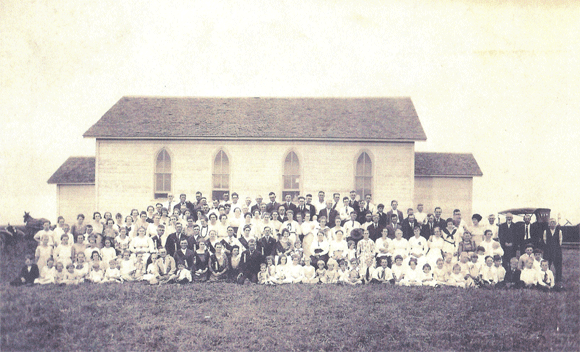
Picture Caption: Crowd gathered at the 6th anniversary celebration of the Golden Ridge Grange #1609. Handwriting on the back of the picture identifies the two babies being held. One mother is Mrs. Herbert Chapman holding baby Alvin, and the other mother is Mrs. William Hammond holding baby Ruth (now Ruth Kemp of rural Clay Center).
Wakefield Museum MUSINGS: "Grange Hall"
By Jim Beck, Curator
We are always amazed by the sequence of events that can be triggered by one simple question. One day not too long ago Virgil Visser, a resident of rural Wakefield, came to the museum with a question about some building ruins in one of his pastures. It seems that he was showing the remnants of the building’s foundation to a granddaughter who peppered him with all sorts of questions that he couldn’t answer. His curiosity was aroused, so he decided to find out what he could about the building.
Virgil had known from a previous owner of the pasture that the building was at one time a Grange Hall. Museum records indicated a Grange Hall in another part of the county, but we did not know about a Grange organization in his neighborhood. One day a museum staff member came across a picture of the Golden Ridge #1609 Grange Hall. We knew we had the picture of the building that had at one time sat atop those foundation ruins because of the documented location of the Golden Ridge schoolhouse in the same vicinity. The picture shows a large crowd that had gathered to celebrate the 6th anniversary of the organization on June 9, 1920.
Now we knew quite a bit more about the former glory of those foundation ruins. But the discovery about the Grange Hall merely led to another mystery. On the back of the picture, someone wrote that the Grange Hall had recently been purchased from a Catholic Church in Wakefield. No one at the museum had ever known of a Catholic Church in Wakefield. Later we found some information about former parishes in the Diocese of Kansas. We learned that itinerant priests offered Mass in the homes of settlers in and around Wakefield beginning in 1878. The parish was named St. Nicholas. By 1891 they had a building that was deeded to the bishop in 1903. The building was sold in 1919.
Now we knew about two former lives of those foundation ruins. First it was a house of worship, and then it served as a Grange Hall to meet the social needs of residents in the Golden Ridge neighborhood of rural Wakefield. Never hesitate to bring your questions to the museum. You don’t know what answers your question could lead to.
The museum operates under its Winter schedule through the end of March (Saturdays and Sundays 1-4). Bring your children and grandchildren on February 25, 1-4, for a dress up day. Children can don aprons, vests, and hats. Have your photo taken in costume.
|


